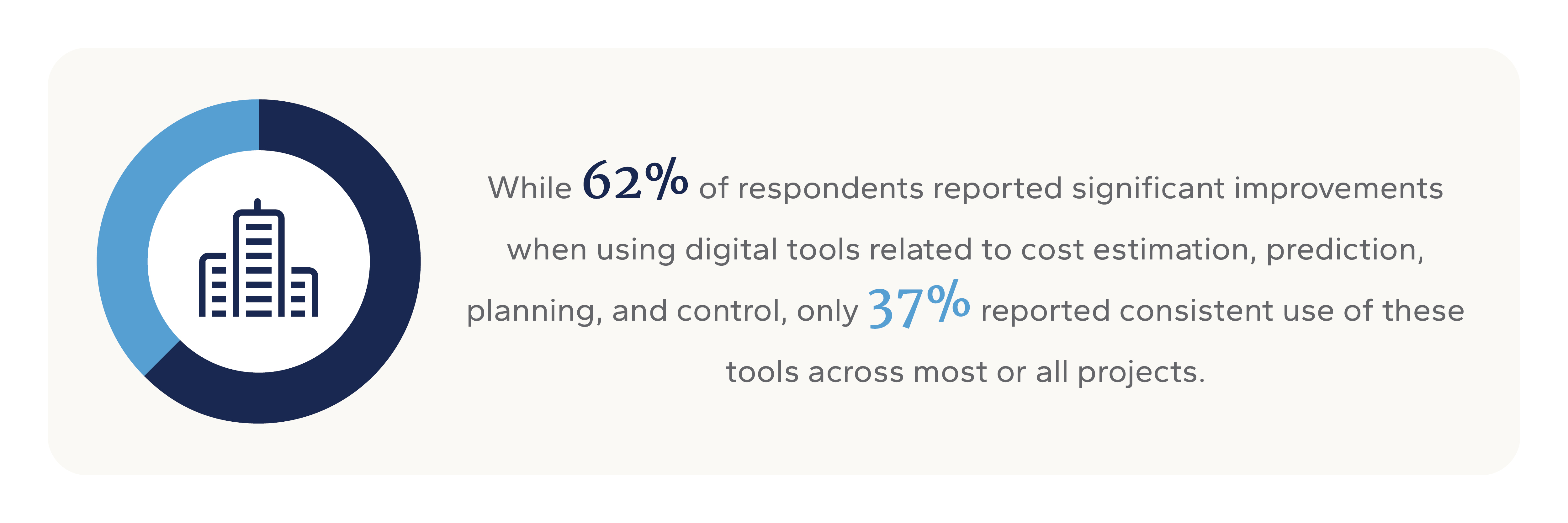Key Takeaways
- An ineffective or non-existent data practice can result in lost sales opportunities, inaccurate forecasts, wasted time, and a reduction in productivity.
- Data-driven culture begins with strategy and top-down buy-in.
- By investing in data analytics and creating a data-driven culture, you can improve your organization’s operations and make better business decisions.
As the world becomes increasingly data-driven, must adopt better practices to remain competitive. However, the construction industry is notoriously slow to adopt new technology.
A 2023 RICS global survey reveals a discrepancy between the construction industry’s perceived benefits of digitalization and the actual rate of adoption. And McKinsey found that construction companies spend one to two percent of revenue on IT, as opposed to three to five percent across other industries.

Benefits of a Robust Data Strategy in Construction
Often the barrier to change is cost and effort. According to IBM, bad or incomplete data costs U.S. businesses up to $3.1 trillion a year.
Further, an ineffective or non-existent data practice can lead to lost sales opportunities, inaccurate forecasts, wasted time, and a reduction in productivity.
Cost Tracking and Reduction
A sound data strategy equips construction companies with a more complete picture of their business. This data can help you better track project costs, identify areas to reduce costs, and make more accurate predictions about profitability.
Resource Allocation and Efficiency
Analyzing historical project data allows you to allocate resources effectively and avoid budget overruns. The result is more accurate bidding and the potential to win more projects.
Improved Accuracy and Decision-Making
A robust data strategy ensures up-to-date information for streamlined decision-making. Incorporating automation also reduces manual processes, which are more prone to human error.
Risk Mitigation
Analyzing historical data can help you implement proactive risk measures early in the project lifecycle. Real-time data insights allow for timely adjustments and course corrections, leading to more efficient operations.
How to Improve Your Data to Increase Company Performance
Here’s what to consider when building your data strategy:
1. Understand what your data represents.
Before you can effectively use data to improve your construction business, you need to know what you are looking at. This includes identifying different types of data you collect, such as project information, resource utilization, and financial data. Once you understand your data, you can identify the key metrics and indicators that will be most important to your business.
2. Centralize your data for a single source of truth.
One of the biggest challenges in the construction industry is the lack of centralized, accurate data. That’s why you should consider investing in robust data collection and management systems. These systems handle a wide variety of data types, from project plans and resource utilization to financial data and customer feedback.
3. Use visualization tools to make data more accessible.
Your employees are often busy on the job site and may not have the time to sift through large amounts of data. Consider investing in data visualization tools that allow quick views of key metrics you’re tracking.
4. Invest in data analytics and modeling.
Once you have acquired and organized a robust data collection, you can begin to use data analytics and modeling to improve your business. This includes using data to optimize project schedules, identify inefficiencies, and improve resource utilization.
5. Automate data solutions to improve operations.
As your company grows, it will inevitably create technical debt — older, legacy systems that don’t make sense to replace, yet still need to interact with the new, cloud-based tools.
One solution is Robotic Process Automation (RPA). RPA can automate repetitive, time-consuming tasks such as data entry, data extraction, and data processing, reducing the risk of human error. This can help to improve the accuracy, efficiency, and speed of data collection, processing, and analysis.
Consider your invoice approval process. Starting with a PDF invoice from a subcontractor, RPA can scan the invoice, pull out the needed information, and send the approver a message in Microsoft Teams. The approver is then able to see the invoice details, modify them if necessary, save the invoice in SharePoint, and then approve or reject the invoice. Once the invoice is approved, the automation launches the invoicing application, uploads the data, and saves the record. When finished, it closes the application and sends an alert that the invoice was created. The invoice is added to an Excel spreadsheet that logs every transaction.
6. Create a data-driven culture.
Data should be integrated into all aspects of your business, from project planning and execution to decision-making and resource allocation. Begin your journey to becoming a data-driven organization by downloading our Data Analytics Playbook.
Common Challenges for Construction Companies
Data and reporting projects do not come without challenges. Top challenges include:
- Change Management: Change starts at the top with executive leadership buy-in. Starting initiatives without a plan in place can lead to poor user adoption.
- Talent Shortages: A limited IT staff can cause strain when undergoing new initiatives.
- Training: Users must have access to resources.
- Security: Maintaining compliance with data protection regulations and ensuring data security is vital.
- Communication Between Operational Divisions: Construction companies have a variety of cost and revenue centers. Information silos often emerge, creating duplicated and misaligned data.
These challenges can be overcome by enlisting the help of a data solution provider. A data advisor that provides IT outsourcing and staff augmentation can help foster a data-driven mindset in employees, alleviate the burden of talent shortages, provide user training, and ensure data security protocols are in place.
Get Started One Step at a Time
By understanding your data, implementing robust data collection and management systems, using data visualization tools, investing in data analytics and modeling, and creating a data-driven culture, you can improve your organization’s operations and make better decisions.
Strategies to Become a Data-Driven Company

Construction
We can help you build a solid financial future.

